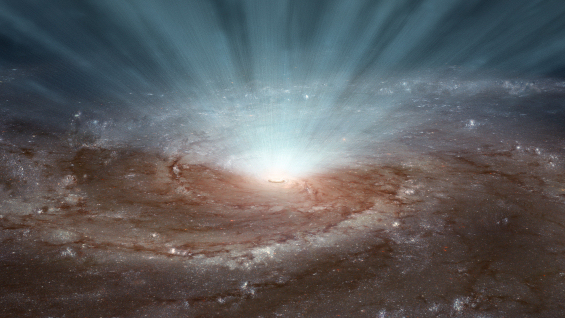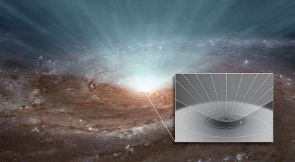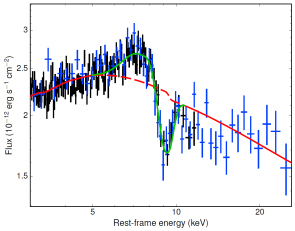Widespread wind from black hole can shape star formation
19 February 2015
Astronomers have discovered that the winds from supermassive black holes at the centre of galaxies are blasted out in all directions. This new finding was made possible by observations with ESA's XMM-Newton and NASA's NuSTAR X-ray telescopes and it supports the picture of black holes having a significant impact on star formation of their host galaxy.
 |
| How black hole winds blow. Credit: NASA/JPL-Caltech |
At the core of every massive galaxy in the Universe sits a supermassive black hole, with a mass some millions or billions of times that of our Sun. Some of these black holes are active, meaning that there is a frenzied flow of matter in their vicinity: the intense gravitational pull of the black hole causes matter to spiral towards it in an accretion disc and at the same time part of that matter is cast away through powerful winds.
For the past few decades, astronomers have investigated if and how these inflows and outflows of matter may have large-scale effects on the host galaxy and, in particular, on its star formation activity. While such an interaction would explain several observations, including the correlation between the mass of stars in the bulge of a galaxy and the mass of its central black hole, it is by no means obvious that the black hole could have an impact on its host galaxy as a whole.
"Black holes are powerful objects, but their gravitational influence does not extend much beyond the very inner parts of a galaxy," explains Emanuele Nardini of Keele University, UK.
"If black holes are really to influence the star-forming activity of an entire galaxy, there must be a feedback mechanism connecting the two on a global scale."
One possibility is that the winds driven by the black hole's accretion activity play a role and, as reported in the journal Science, Nardini and collaborators have obtained the first solid evidence supporting this scenario.
The team have looked at PDS 456, a galaxy that lies just over two billion light-years away and that hosts an exceptionally active black hole with a mass of one billion Suns. PDS 456 is a quasar, a class of galaxies that appear as a point source because the brightness produced by their stars is outshone by the emission from the activity of the central black hole.
 |
| Artist's impression of black-hole wind in a galaxy. Credit: NASA/JPL-Caltech; Insert: ESA |
Due to the high temperatures caused by friction in the material flowing towards the black hole, the accreted material shines brightly at optical and ultraviolet wavelengths, and subsequent interactions of this light with highly energetic electrons in the immediate surroundings of the disc also produce copious amounts of X-rays. A comprehensive view of the accreting activity of this quasar could be obtained by observing PDS 456 simultaneously with ESA's XMM-Newton X-ray observatory and NASA's Nuclear Spectroscopic Telescope Array (NuSTAR) mission. The observations were performed on four occasions in 2013, and once again in 2014.
Despite being a very powerful source, PDS 456 was only discovered in the 1990s, as it lies in a very crowded portion of the sky, beyond the centre of our Galaxy. However, even in the early X-ray detections, this quasar revealed a strong absorption feature caused by highly ionised iron – nuclei of iron that have been stripped of all but one or two of their electrons.
"The absorption line is blue-shifted with respect to what we would observe in the laboratory, indicating that it is caused by iron ions that are moving towards the observer, hence away from the black hole: in other words, we are seeing an outflowing wind," explains Nardini.
This line has now been detected in many other quasars, but due to its relative vicinity to us, PDS 456 offers ideal conditions to observe it in detail.
Prior to this study, astronomers used this absorption feature to learn that the wind is blowing at one third the speed of light. But the data were not enough to extract more information about the outflow of matter from this mighty black hole.
This is where the new observing campaign made a difference.
With a series of high-resolution spectra taken at five different epochs, the astronomers could scrutinise the data in unprecedented detail. This allowed them to uncover something new: not only they could see the absorption caused by the iron ions, now they also detected direct emission from those ions.
 |
| XMM-Newton and NuSTAR spectrum of the quasar PDS 456. Credit: Courtesy of E. Nardini, Keele University, UK |
"It was a most welcome surprise," says Nardini.
The emission signature in the spectrum was detected at a slightly lower energy than the absorption feature.
"This indicates that the emitting ions lie outside our line of sight: we are seeing material that is flowing away from the black hole, not only towards us but in every direction," he adds.
Such a pair of emission and absorption lines is called a P-Cygni profile, as it was first observed in the variable star P Cygni. It is characteristic of a gaseous envelope expanding away from the central source, and it was never before observed in the wind driven by the inner accretion disc of a supermassive black hole.
With this new feature detected in the spectra of PDS 456, the astronomers could finally study the geometry of the wind blown by the black hole, revealing a wide, almost spherical outflow of matter.
"Knowing the speed, shape and size of the winds, we can now figure out how powerful they are," comments Fiona Harrison of the California Institute of Technology in Pasadena, California, who is a co-author on the paper and the principal investigator of NuSTAR.
The data indicate that the outflowing material amounts to about ten times the mass of the Sun every year, and that the kinetic power it releases into the surroundings is about 20 per cent of the total energy emitted by the quasar.
The wide shape of the wind already shows that the black hole must have quite an impact on the host galaxy, and the estimated amounts of mass and energy that are being blown away seem to confirm that the outflow is able to trigger an effective feedback mechanism on the galaxy as a whole. While the black-hole wind consists of ionised gas, its power has the potential to set larger outflows into motion, eventually driving away the galaxy's reservoir of molecular gas – the raw material that is needed for stars to form.
What the astronomers detected in the relatively nearby quasar PDS 456 might be the early stage of a feedback process that more distant quasars underwent long ago, suggesting that supermassive black holes did in fact contribute to regulating the star-forming activity of the galaxies we observe today.
"This is a great example of the synergy between XMM-Newton and NuSTAR," says Norbert Schartel, XMM-Newton project scientist at ESA.
"The complementarity of these two X-ray observatories is enabling us to unveil previously hidden details about the powerful side of the Universe."
More information
"Black hole feedback in the luminous quasar PDS 456" by E. Nardini, et al., is published in the 20 February 2015 issue of the journal Science.
The results are based on observations performed with ESA's XMM-Newton X-ray observatory at energies between 0.5 and 10 keV, and with NASA's Nuclear Spectroscopic Telescope Array (NuSTAR) mission at energies between 3 and 50 keV. The observations were performed simultaneously with the two observatories on four occasions between 27 August and 21 September 2013; a fifth observation was performed several months later, on 26 February 2014.
The European Space Agency's X-ray Multi-Mirror Mission, XMM-Newton, was launched in December 1999. The largest scientific satellite to have been built in Europe, it is also one of the most sensitive X-ray observatories ever flown. More than 170 wafer-thin, cylindrical mirrors direct incoming radiation into three high-throughput X-ray telescopes. XMM-Newton's orbit takes it almost a third of the way to the Moon, allowing for long, uninterrupted views of celestial objects.
Contacts
Emanuele Nardini
Keele University
Keele, UK
Email: e.nardini![]() keele.ac.uk
keele.ac.uk
Phone: +44-1782-733531
Fiona Harrison
California Institute of Technology
Pasadena, California, USA
Email: fiona![]() srl.caltech.edu
srl.caltech.edu
Phone: +1-626-395-6601
Norbert Schartel
ESA XMM-Newton Project Scientist
Directorate of Science and Robotic Exploration
European Space Agency
Email: Norbert.Schartel![]() esa.int
esa.int
Phone: +34-91-8131-184




